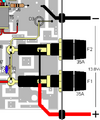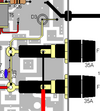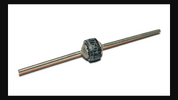Long night,
not a problem, i completely understand how something can read more complicated than it actually is.
so, the old diode was just a button with no leads on it.
the bottom of that old diode was soldered to the board.
that is ground.
so, the NON-banded end of your new diode (anode) gets soldered to that same spot.
the top of your old diode had a wire soldered to it. that wire had one end soldered to the fuses, and the other end soldered to that trace that is directly behind the spot where the old diode was. this wire was bent down so that the middle of it could be soldered to the top of the old diode.
looks like this:

so now you have your new diode with the NON-banded end soldered to that ground trace (where the diagram above says "D3").
the next step is to bend the other lead (banded end) over towards the back of the amp and solder it to that trace in the diagram that is directly to the right of the ground trace.
at this point you will have a diode with one end soldered to the ground trace (where the D3 label is in the diagram above), and the other end soldered to that trace that is just to the right of it (in the diagram above).
the last step is to get a short length of wire (12ga. or bigger, don't use thin wire) and solder one end to the top lead of your new diode (the end that goes to that trace on the right). the other end of this wire gets soldered to the fuse holder.
i know that we don't yet know which end of your new diode is the "banded end (cathode) and which end is the NON-banded end (anode).
the way we will figure this out is with our digital multimeter set to diode test function (probably has a diode symbol on that switch position).
take your positive (red) lead and touch it to one end of the new diode.
take your negative (black) lead and touch it to the other end of the new diode.
now look at the display on the meter. if it reads a voltage like somewhere around .6 volts (.583 for example) then your black lead is connected to the cathode (banded end) of the diode. put a mark or a line on this end of the diode.
if your meter doesn't read anything, then switch the leads around and re-read the paragraph above.
hope this helps.
LC



